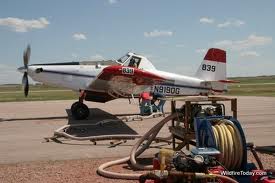 By GRANT SCHULTE, Associated Press
By GRANT SCHULTE, Associated Press
State and local officials are preparing for another possible round of wildfires in Nebraska by providing additional training and more equipment for first responders who fought massive blazes last year.
Nebraska has added a single-engine firefighting plane to its arsenal this fire season as part of the Wildfire Control Act, passed by the legislature earlier this year.
The privately-owned single-engine aerial tanker…a SEAT for short…is contract by NEMA…the Nebraska Emergency Management Agency…and will operate out of bases in Alliance, Valentine and Chadron.
The Nebraska Forest Service says the SEAT arrived in Valentine last Monday and will move among the 3 bases as needed.
 The SEAT and the other parts of the Wildfire Control Act, which includes funding and extra training to help local firefighters meet national emergency-response standards, are a response to last year’s massive wildfires in remote parts of Nebraska…especially the northwestern portion from Valentine on west.
The SEAT and the other parts of the Wildfire Control Act, which includes funding and extra training to help local firefighters meet national emergency-response standards, are a response to last year’s massive wildfires in remote parts of Nebraska…especially the northwestern portion from Valentine on west.
State Forester Scott Josiah has said he expects Nebraska to have larger and more intense “mega-fires” in the coming years because heat, drought, climate change, and the spread of the highly-flammable eastern red cedar tree.
According to NEMA, the state experienced 1,570 wildfires last year that burned a total of 786 square miles — nearly seven times the size of Omaha – destroyed 65 buildings, and cost the state about $12 million. State emergency officials said 98% of the wildfires were caused by lightning strikes.
The state has avoided major fires this year because of greater humidity and fewer windy days, said Don Westover, a rural fire protection leader for the Nebraska Forest Service. But Westover said the state could easily slip back into a severe fire season after a week of hot, dry weather.
“We’ve dodged a bullet, so far,” Westover said. “But things can dry out in a week or so, so we’re not letting our guard down.”
NEMA assistant director Al Berndt traveled the state last week to discuss ways the state can provide help to local firefighters, visiting with departments in Ainsworth, Valentine and other rural, northern Nebraska agencies that were overwhelmed last year.
Berndt says he urged local fire officials not to hesitate to request state aid if they believe a fire is too much for them to handle alone. Mobilizing emergency helicopters and other state resources to a rural fire scene can take 8 to 12 hours, and he says that additional time allowed some of last years’s fires to spread over a larger area.
“The quicker that information can travel up the chain, the better,” says Berndt. “It takes time to put a large-scale response together.”
Recent rain has helped ease the drought and fire risk in Nebraska, but most of the state remains dry…with a U.S. Drought Monitor report released last Tuesday showing nearly 98% of the state still in some stage of drought.
More than 39% was still classified as having “extreme” or “exceptional” drought conditions, the most severe classifications on a 5-point scale. The conditions were worst in parts of western and southern Nebraska, including areas that were hit by fires last year.
Region 24 Emergency Management Agency director Doug Fox…whose agency include Boyd, Brown, Cherry, Keya Paha and Rock counties, says the state is working to thin the trees and vegetation that helped fuel many of last year’s massive fires
Fox says emergency crews have also signed with contractors that can quickly provide bulldozers and heavy machinery to set fire lines. “If we get another week of hot, dry weather, like we have now, a lot of moisture will be gone,” he says. “If you have the right conditions, things can escalate really quickly.”
